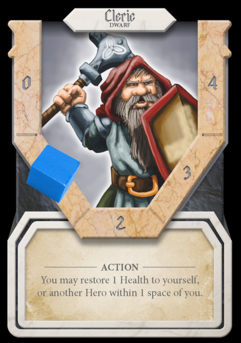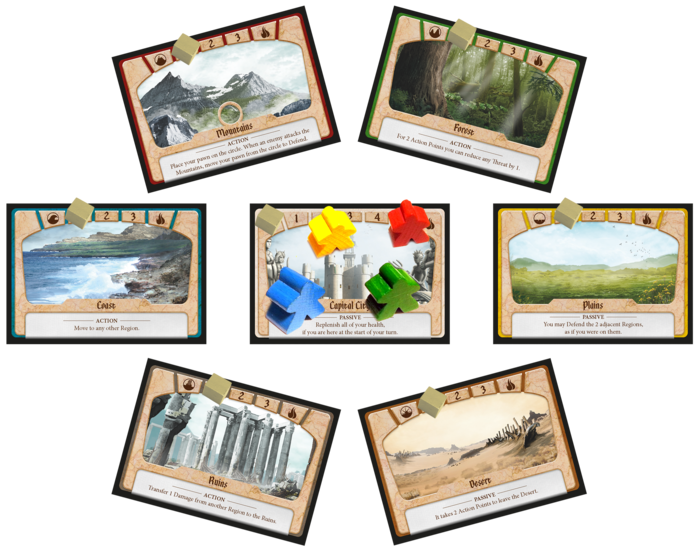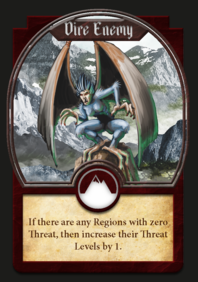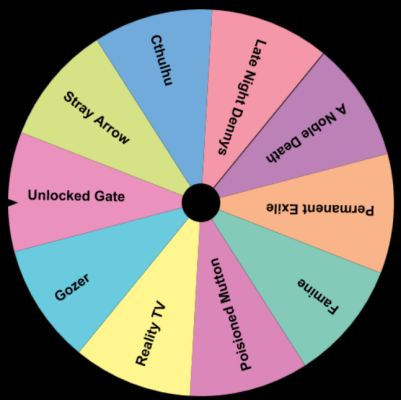Your tiny epic kingdom is in peril – dire peril- and only a small band of 1-4 defenders can save it! Or die trying.
You’ll probably die trying, honestly.
Tiny Epic Defenders is the co-op Micro-game sequel to Tiny Epic Kingdoms, where it pits you and your friends against a truly brutal challenge to stave off the destruction of your capital city. TED may be a micro-game, but don’t be fooled by its size – this is not an adventure for the weak willed or sore loser. While you choose your difficulty level at the start of the game, what you’re really choosing is whether you want to lose later in the game or just lose right at the beginning. That’s a bit of an exaggeration, of course. It’s likely possible to win.
At least, in theory. Chances are most of your games will end in complete annihilation. But we’ve heard that victory is achievable!

The Cleric Hero
Prototype Shown
That said, much of the appeal of TED stems from its difficulty. It takes no prisoners and doesn’t hold your hand. Without both luck and skill, you’re going to be monster chow, but like other difficult co-ops, that’s part of what keeps you coming back. It proves a good format for a micro-game too, with punishing but quick plays that allow you to try the game again immediately and learn from your mistakes. The replay value stems from the inherent desire to not only beat the game, but to crush it as it crushed you. It’s a vindictive motivation, but effective.
In terms of actual gameplay, TED is fairly simple. You have seven cards representing, respectively, the Capital City and the surrounding regions (Forest, Mountain, Plains, etc). The Capital City lies in the middle, with the remaining cards randomly laid out in a circle surrounding it. These are the lands that you must defend.
Each player begins with a meeple and a Hero role card. Roles provide you with unique abilities and bonuses in addition to the normal actions all players have: Moving, Fighting, and using the ability of the region you’re in.

Behold your kingdom in peril.
Prototype Shown
You then assemble the monster decks.
Yes, decks. There are two. Remember when we told you that this game was hard?
The first deck – the Turn Deck – is comprised of three monsters and one or two cards representing each player, depending on how many of you there are. The second deck – the Horde Deck – is made up of three more monsters and a number of more powerful Dire Enemies, depending on your chosen difficulty level. You then randomly select an Epic Foe – these are big, mean monsters with special abilities that you’re glad you only have to fight one of. If you live that long anyway. It goes the bottom of the second deck.
And with that, you’re ready to start the onslaught. You shuffle the Turn deck then flip the cards over, resolving them as you go. When a normal monster is drawn, it attacks two regions on the board. The damage can be absorbed by the land, raising its Threat level by one. However, if a player is on a location that is being attacked, or has a relevant special ability, they can choose to defend the land by taking the hit themselves. This reduces your health by one. Once (not if) a player has zero health, they are incapable of defending until they end their turn in the Capital City, which will restore them to full health.
Regions are not so fortunate. If a location reaches four Threat, it is destroyed; any future attacks dealt against that region strike the Capital City instead.
Oh, and you can’t defend the Capital City from within. Nice try though.

Harpies are always annoying.
Prototype Shown
As the game progresses, you will also encounter Dire Enemies: these only attack one location, but they have a special effect that goes off when revealed and, unsurprisingly, it’s pretty bad. On the positive side, though, they drop loot! If you defend against a Dire Enemy, you’re rewarded with an Artifact, which are powerful one-shot abilities that you can use during the game.
When your player card is drawn, you take your turn. You are given three actions and several ways to use them. This includes moving to an adjacent location, activating Artifacts, or using any relevant special ability that either you or your location has. Most importantly, you can also Fight to restore a location, reducing its Threat and making it less likely that the location will fall during the next monster wave.
After the Turn Deck is been depleted, the top card from the Horde Deck is shuffled in to the Turn Deck. Then you start over. Gameplay rinses and repeats, with the players’ turns slowly being thinned out under the wight of the invading forces, until you get to the bottom of the Horde Deck and unleash the Epic Foe. This monster has a number of hit points, its own share of nasty abilities, and it camps out in one of your kingdom’s regions. To kill it and secure victory, players must travel to its location and spend actions to attack it.
In the meantime, you’re also still dealing with all those other enemies.
We did mention this was hard, right?

Come spin the Wheel of Doom!
Aw, death by Unlocked Gate. A tale as old as time…
One of the most interesting aspects of the game is effectively having a random turn order. While it adds an additional level of tension to the game, it could also be frustrating to players who don’t enjoy the fickle whims of Lady Luck. Where each player’s card falls in the Turn Deck can be the difference between winning and losing, and we don’t just mean in an abstract, complex way. There is, quite unequivocally, an observable causal link between A (your card being at the very bottom of the damn deck) and B (you being eaten by a giant dragon).
While this balances out Pandemic-style with the fact that you’re working as a team and actively trying not to put yourselves into a situation where one person holds the entire kingdom’s chances of survival, the game still tilts toward luck. It’s an innovative turn order mechanic, though, and deserves points for trying something new. Plus, it’d be too easy to min-max the game if the turn order were constant, and much of the fun in the game comes from not knowing which card is coming up next.
In short, Tiny Epic Defenders is punishing and merciless, with players quickly having their backs to the wall and defeat could come with any card. But it’s this same brutality that makes it so fun and exciting. With TED, winning is not the default. Winning is an accomplishment – and it definitely feels as such. It is to be savored like a fine steak: bloody, warm, and most of all, rare. If you’re up to the challenge, you can find out more about it over on its Kickstarter.
[sc:Preview-Sealer ]
